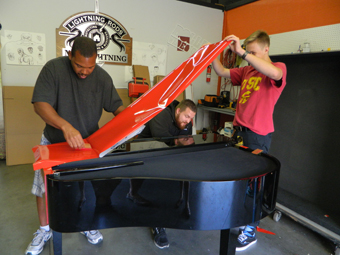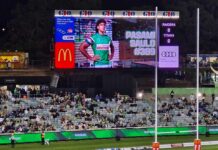12-Point SignWorks is a sign company that has always marched to the beat of its own drum. The full-service sign & design company in Franklin, Tennessee works on everything from dimensional pieces to exhibit projects to wraps.
But it’s the custom, creative jobs that the shop enjoys working on the most.
“We definitely look at ourselves as more of a creative company,” says Rich Novia, creative director at 12-Point SignWorks, “offering creative solutions through digital media and fabrication solutions. For us, it’s the big projects that really get us going and allow us to be designers and fabricators.”
The shop got just the kind of job it likes when music star Kelly Clarkson’s management approached them about wrapping a piano and a bass for use in her Christmas special, Kelly Clarkson’s Cautionary Christmas Music Tale.
Word of mouth earned the shop the gig: Clarkson’s management called on 12-Point SignWorks after finding out they had previously wrapped pianos for Alicia Keys and other musical acts.
12-Point SignWorks had some creative freedom on the wraps as the management company only requested a “Christmas red” vinyl.
“A lot of our clients give us a lot of freedom as to the materials, the finishes, and the things that we choose,” says Novia, “I think we’re starting to get the reputation where people come to us and say, ‘what do you guys think we should do?’”
The sign company selected 3M™ Scotchprint® Wrap Film 180-G13 Gloss Hot Rod Red vinyl to wrap both instruments. The material’s ability to stretch around the complex curves of the instruments was important, as was the durability of the finish since the instruments would be travelling.

Removability was another factor as the wraps would only be on for rehearsals and the show—about two months. “It has to come off,” says Novia. “These are expensive black lacquer finishes.”
With the material chosen, 12-Point SignWorks ran into its first challenge—how much vinyl to order?
“It’s always tough with material usage. For us, we always buy ten-, twenty-, and fifty-yard rolls whenever we can,” says Novia. “But I don’t really know how many other people are going to want a ‘Christmas red’ wrap.”
The shop gambled and ordered only ten yards of the vinyl. “I could buy a twenty-five- or fifty-yard roll,” says Novia, “but it would eat into our profit pretty good. And then it would sit here.”
Novia compares wrapping instruments to working on exotic cars. “I can’t have razorblade marks on those cars, and I can’t have those mistakes on a $25,000 piano,” he explains. “We have to approach it very methodically and with caution.”
Novia also says, on unique jobs like this one, the trick is to proceed slowly. “A lot of people rush into it, and they automatically just start pushing vinyl on it,” he says. “I always tell the guys who wrap stuff in here, including myself, to really take the extra five or ten minutes to get familiar with the unique piece you’re going to do.
“If you really get to know the piece beforehand, you can set a plan on how to attack it. The biggest thing with those types of unique objects is hiding your seams and tucking the vinyl into areas where it can’t be seen. And I think you really need to plan for that before you just start throwing vinyl on it.”
Bass. This was the first time the shop had wrapped a bass instrument, and its unique shape and lack of flat surfaces provided a bit of a challenge.
12-Point SignWorks started by disassembling the instrument. Luckily one of their employees, Chuck, is an avid musician and knew his way around the bass. He was able to disassemble it for wrapping and then reassemble and retune it before it was shipped back out.
A seamless wrap wasn’t possible, but the shop was able to hide the seams in the beveled edge along the side. They used knifeless tape on the side to achieve a smooth finish and to avoid damaging the bass.
“For the most part, the whole front and the back are all one piece. Then there’s a strip seam down the center around the edges where it comes together,” explains Novia.

It took one installer a day-and-a-half to finish the bass. A combination of heat and tugging got the vinyl to hug the instrument’s curves. Additional installers jumped in at the end to complete the last-minute touches on time.
And time was certainly of the essence—as the shop received the instruments on a Wednesday night and only had until that Friday afternoon to complete the wraps and ship the instruments back out.
Piano. Like the bass, 12-Point SignWorks started by putting the piano on its legs and then disassembling it. (Note: Chuck’s knowledge was once again “instrumental” on this disassembly.)
“We took the top off, as well as a lot of the key covers,” says Novia. “We removed as many parts as we could.” (Note: According to Novia, wrapping this way gives a lot of the vinyl good bite under certain areas.)
Installers even took off small parts like hinges so that they were able to wrap underneath them. “It looks better,” says Novia, “and even though [the wrap] was for two months at the most, we still wanted to put our best foot forward on it.”
Wrapping the piano was a bit easier because the instrument had a lot of flat, smooth surfaces. However the curve in the back of the piano did prove a bit difficult. The shop’s previous experience wrapping pianos helped them to tackle the complex curve. “We always cut a little extra, and we always try to test fit pieces as best we can,” says Novia.
With the help of heat and some squeegees, the installers got all of the vinyl down. They also did some cutting with knifeless tape and knives where necessary. “On the piano, you do cut a little bit more,” says Novia, “especially around in the key areas—you just can’t get the tape in there.”
It took two installers about a day-and-a-half to finish the wrap, with additional employees stepping in to help place some of the larger pieces of vinyl. (Note: The shop also wrapped the piano stool in the red vinyl.)

12-Point SignWorks also had some creative freedom in the wrap process, and they let some of the black show through on areas of the piano where they thought it looked good. “A lot of that stuff is done on the fly when you start to wrap something,” says Novia.
When the wraps were completed, 12-Point SignWorks only had about a yard-and-a-half left of vinyl.
“We were actually getting kind of nervous,” says Novia. “When you do material like that, you have no room for mistakes. If we ruined the top putting it down, that was it, it would blow the deadline.”
The shop ended up making the tight deadline and was able to add another unique wrap job to their set list.
By Ashley Bray
All photos: 12-Point SignWorks











